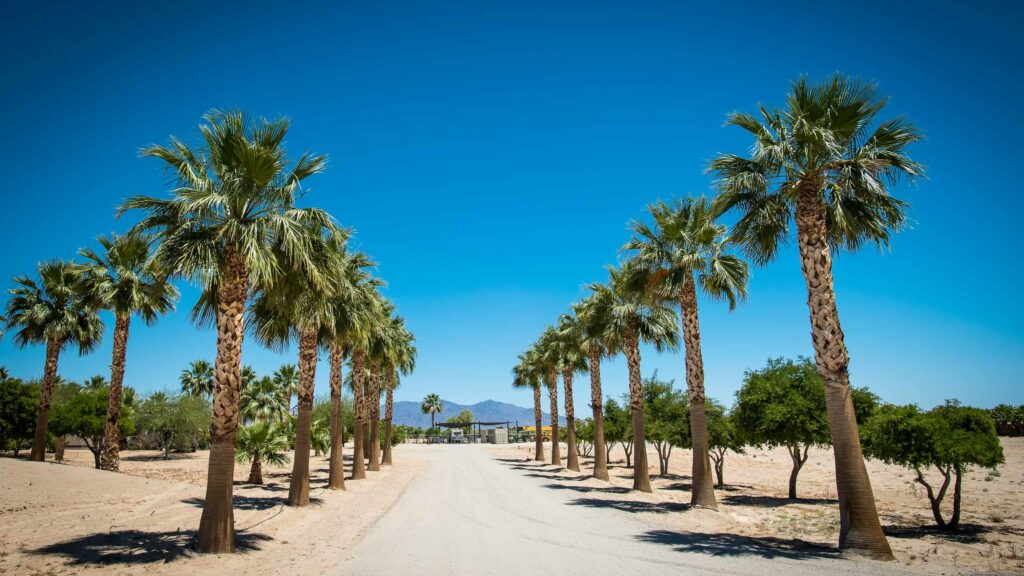Palm trees conjure images of tropical islands, sunshine, and warm weather. They make attractive garden accessories, but what are the palm tree’s northern boundaries? How far north can one safely expect to grow a happy, thriving plant?
Palm trees can thrive as far north as Washington State and Connecticut. Their well-being is greatly dependent on the species as well as the locality. Most palms prefer coastal regions and thrive in tropical and subtropical areas of the US, like Hawaii and the Southern coastlines.
If you are looking to add a palm tree to your landscaping, we will provide you with all you need to know about whether your location is a feasible home for these plants. We will also offer advice on how palm trees can be helped to thrive in the northern boundaries.
How Far North Do Palm Trees Thrive?

Palm trees are more commonly associated with the tropics, but some species can tolerate surprisingly low temperatures, which has allowed them to be found as far as the 44° latitude line both North and South.
The ability of a palm tree to withstand cooler temperatures will be determined by its species, with hardier species like Arecaceae having the ability to survive brief chills and the odd snowfall.
Indeed, Washingtonia and Rhapis, within the Trachycapeae genus of the Arecaceae tribe, are found as far north as Washington State and Southern Connecticut.
One of the easiest ways to determine the northern boundaries for palm trees to thrive is to find out where they are rated on the UDSA Plant Hardiness Zone Map. This map provides valuable data on where plants will thrive within zones of different ratings.
Most palms will be happy within the USDA hardiness zones from 12a to 13b. The hardy species we have mentioned can manage the hardiness zone into the range of 8a and even as far as 7b.
How Do Species Affect How Far North a Palm Tree Can Survive?
There are many different palm tree species, and as we have mentioned, the palm species plays a role in how far north it will thrive. Certain species are more robust than others.
Most palm species prefer warm coastal regions and some desert areas; these areas are more commonly found along the tropics and subtropics and rarely inland. However, some hardy plant species can handle surprisingly low temperatures that allow for their growth in areas that are relatively far north.
Fan palms are considered to be the more cold-tolerant palms, with the Windmill Palm or Trachycarus Fortunei being able to survive in temperatures as cold as -10°F. This species has been known to grow to maturity in countries as far north as Norway.
Other hardy species are the Needle palm (Rhapidophyllum hystrix) and the Cabbage Palmetto (Sabal Palmetto), both of the Arecaceae tribe.
Pinnate leaf palms are less hardy and won’t be found too much further north of the tropics, although some species like the Jubaea chilensis can tolerate temperatures as cold as 10°F. Date palms and coconut palms do not manage cold weather well and will be more usually found in tropical and warmer climates.
How Does Size Affect How Far North a Palm Tree will Grow?
If you are located along the northern boundaries of the palm tree survival zone, one thing that can make a difference in how well your plant will grow is its size. The more shrub-like your palm plant, the more hardy it is likely to be.
Thicker trunks and smaller fruit are also a sign of a higher level of hardiness; Needle Palms, Cabbage Palmettos, and Windmill palms all display either one or two of these elements: ground-based shrubs or thick-trunked trees.
Thanks to this variety, you can enjoy a variety of palm sizes even within the northernmost boundaries where palms will thrive.
How Can Your Palm Tree Thrive in the Northern Boundaries?
As much as species will be a big help to how well a palm tree will grow, several other factors should be taken into consideration, as well as steps taken that will help a palm tree thrive.
While a species may be hardy, you may end up with a scraggly, unhealthy plant without proper care and thought about where it is planted and when it is produced. These are three essential factors to consider when cultivating a healthy palm tree:
- Species choice
- Shelter
- Planting age
As mentioned, choosing a suitable species is essential for survival in the northernmost boundaries. Opt for a fan-leaf species, as these are hardier and can withstand short exposure to low temperatures.
The shelter is an overlooked element, and if you know you are right on the boundaries of where palms will thrive, we recommend planting your palm in a sheltered area to offer it protection from icy winds and dips in temperature; this will help your palm tree thrive.
When considering adding a palm to your garden, we do not recommend getting a small plant; instead, we spend some money and get an adequately established plant. Most palms take three years to become established. You could keep your palm potted indoors until it reaches a sufficient size before adding it to your garden.
Can You Grow Palm Trees Past the Northern Boundaries?
Not all hope is lost if you live far north or far inland and desperately want to grow a palm tree. Provided you can provide a reasonable environment, palms can be cultivated in otherwise unfriendly climes.
Greenhouses offer an excellent alternative for those who would love to include a palm tree on their property, as do indoor atriums and potted palms. With all of these options, it is recommended that you choose your palm tree with care to ensure that it will thrive in an artificial environment.
Final Thoughts
Palm trees are a popular and attractive garden addition. For a healthy, happy plant, however, we recommend only planting one if you are in the southwestern, southern, or southeastern states; hardy species can thrive as far north as the Washington and Connecticut coastal regions.

